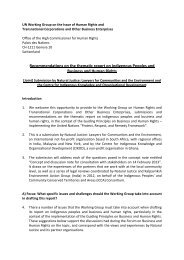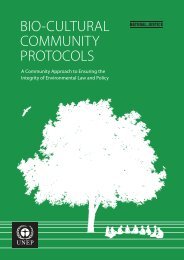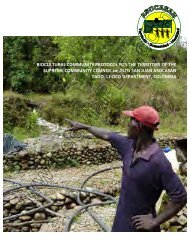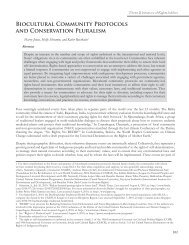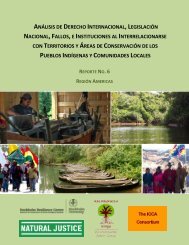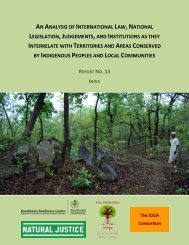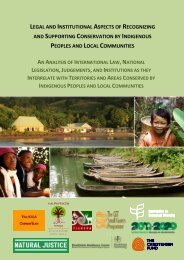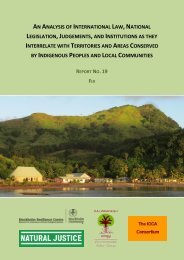Analyzing The Binding Nature of COP Decisions ... - Natural Justice
Analyzing The Binding Nature of COP Decisions ... - Natural Justice
Analyzing The Binding Nature of COP Decisions ... - Natural Justice
Create successful ePaper yourself
Turn your PDF publications into a flip-book with our unique Google optimized e-Paper software.
Some commentators have noted that by its nature, the CBD is more in the realm <strong>of</strong> a s<strong>of</strong>t law instrument. Because <strong>of</strong> the contentious issues addressed by the CBD, the instrument was drafted with a “broad remit,” with many <strong>of</strong> the details to be implemented by individual Parties. 53 Rather than implementing additional hard law instruments, however, the CBD <strong>COP</strong> “develop[ed] s<strong>of</strong>t instruments which are not backed by obligations.” 54Additionally, CBD <strong>COP</strong> <strong>Decisions</strong> themselves, which are <strong>of</strong>ten long and poorly organized, may hamper the hard nature <strong>of</strong> the instrument. 55 One commentator has suggested that because“it is quite difficult to determine the legal strength <strong>of</strong> CBD <strong>COP</strong> [D]ecisions on the basis <strong>of</strong> their wording, it seems that the pragmatic way to determine whether these decisions actually contribute to addressing climate change and biodiversity in a mutually reinforcing manner is to assess state practice, both in relevant international negotiations outside the CBD framework and in implementing CBD <strong>COP</strong> [D]ecisions at the national and local level.” 565. Summary Actions <strong>of</strong> <strong>COP</strong>s inhabit an ambiguous area in the binding/non-‐binding dichotomy <strong>of</strong> traditional international law. While some actions such as amending the governing instrument take place in a manner akin to formal treaty-‐making, other actions such as reaching agreement on decisions occur under less formal circumstances. <strong>The</strong> status <strong>of</strong> this latter category <strong>of</strong> actions is unclear. Applying formal treaty law, such actions appear to be more akin to s<strong>of</strong>t law. 53 Harrop and Pritchard, at 476. 54 Harrop and Pritchard, at 479. Harrop and Pritchard do acknowledge that “[t]he setting <strong>of</strong> global targets has addressed one <strong>of</strong> the foundational inadequacies <strong>of</strong> the CBD, by providing necessary timelines, rates and measures.” Id. However, they note that “the convention’s work on targets has not to-‐date provided instruments that facilitate their national implementation.” Id. 55 See E. Morgera, Faraway, So Close: A Legal Analysis <strong>of</strong> the Increasing Interactions between the Convention on Biological Diversity and Climate Change Law, University <strong>of</strong> Edingburgh School <strong>of</strong> Law Working Paper Series 2011/05, at 2 (noting that “it is difficult to obtain a clear and comprehensive picture <strong>of</strong> the guidance given by the CBD’s Conference <strong>of</strong> the Parties” regarding climate change and biodiversity due to <strong>COP</strong> <strong>Decisions</strong> that are “generally long” and “not always well organized”). 56 Morgera, at 36.



